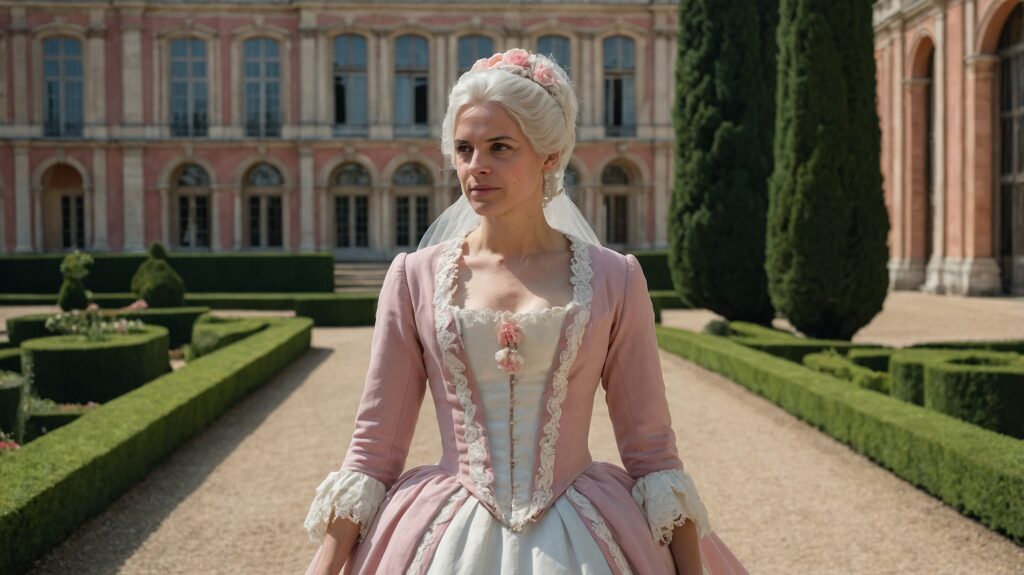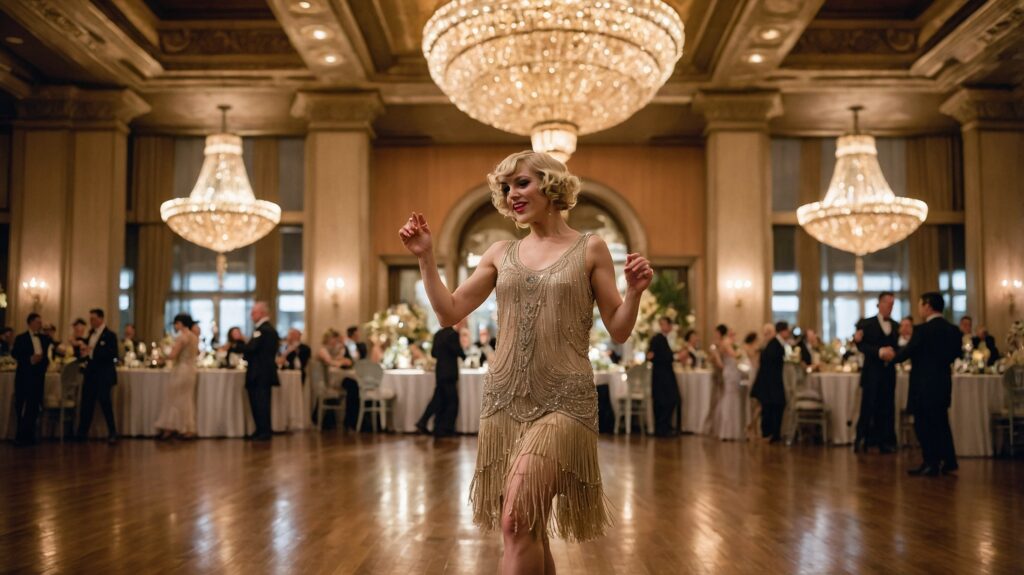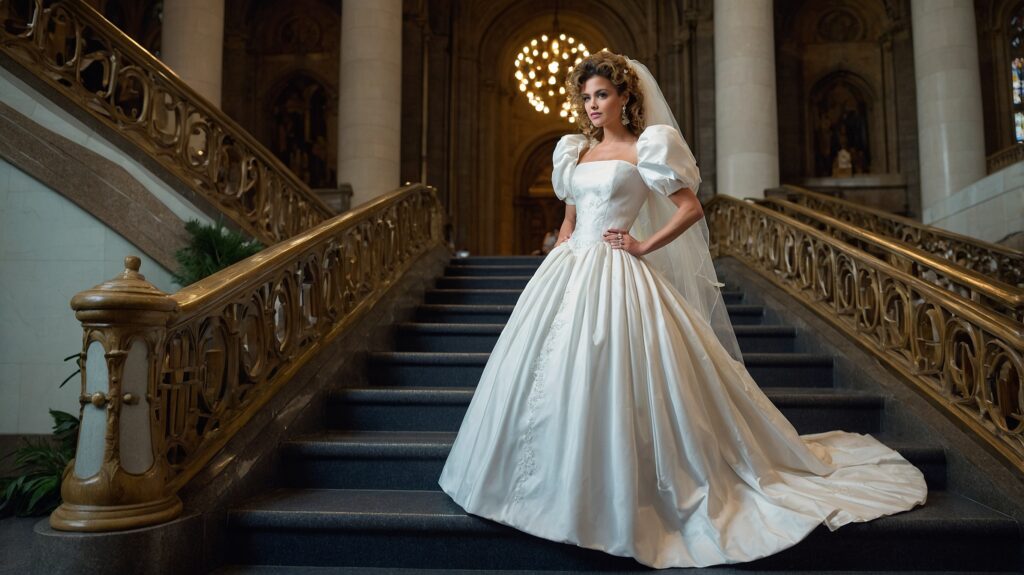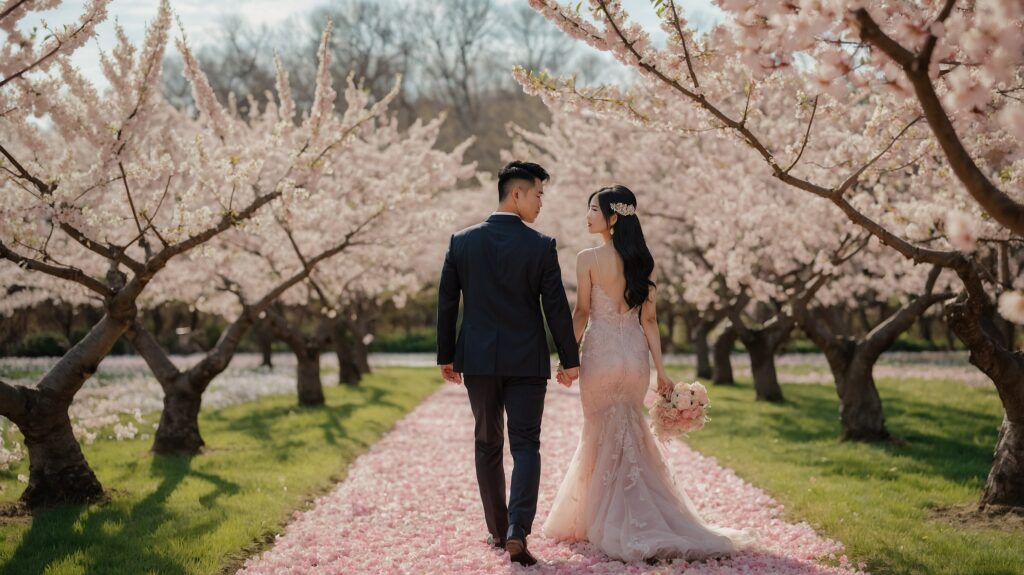Key Takeaways
- White wedding dresses only became popular after Queen Victoria wore one in 1840. Before that, brides wore colorful dresses.
- Ancient Greek and Roman brides wore bold colors like flame, saffron, and yellow.
- In medieval times, blue was a popular choice as it symbolized purity.
- Royal brides in the Middle Ages wore gold or silver dresses to show status.
- Poorer brides often wore their best dress, which was darker in color to hide stains.
- The Victorian era made white wedding dresses fashionable as a status symbol of wealth.
- Early 20th century brides branched out into pastels, silver, and floral patterns.
- Mid-century war brides opted for practical attire that could be worn again.
- The sexual revolution of the 1960s and 70s brought back vibrant hues.
- Modern brides can select any color, but many prefer white or ivory.
The tradition of wearing a white wedding dress is less than 200 years old. For centuries before that, brides chose colors that carried symbolic meaning about their social status, purity, joy or hope. Only the wealthy could indulge in pale colors that would quickly show dirt. The color of a bride’s dress reflected her place in society and the values of the time period.
The Ancient World: Bold Hues Reflected Celebration
In ancient Greek and Roman times, wedding dresses were vibrant and bold. Deep colors like flame, saffron, purple, and yellow were popular choices. These shades were associated with fertility, life, and happiness. A dark flame dress was believed to ward off evil spirits that could curse the couple’s marriage. Saffron dye was expensive, so it indicated wealth and high social status. Greek brides also wore crimson flowers in their hair, signifying sexuality and the loss of virginity after the wedding night.
The Flame Colored Chiton Dress
The traditional wedding attire for Greek brides was the chiton, an ancient tunic dress crafted from a single large piece of fabric, pinned at the shoulders and cinched at the waist. Greek wedding chitons were commonly made from luxurious materials such as silk or linen, highlighting the bride’s status and elegance. Red chiton wedding dresses symbolized the passion and intensity of young love, with many brides choosing this vibrant, attention-grabbing color for its beauty and significance on their special day.
The Color of Fertility and Femininity
Roman brides traditionally wore long tunics or gowns known as stolas, which were a key part of ancient Roman wedding attire. Yellow was a favored color for Roman wedding dresses because it symbolized fertility and prosperity. Brides from wealthy Roman families often had stolas crafted from luxurious saffron silk, highlighting their status. The bright yellow hue was also connected to the goddess Juno, the Roman deity of femininity and marriage, making it especially meaningful for wedding ceremonies.
Warding Off the Evil Eye
Ancient Greeks and Romans commonly believed in the evil eye curse, caused by malicious looks. To protect the bride, wedding guests would wear yellow ribbons in their hair. The vibrant color was thought to ward off envy, curses, and bad luck. Brides chose saffron dresses for the same protective qualities.

Medieval Europe: Blue as a Sign of Purity
During the Middle Ages in Europe, blue was the top choice for wedding dresses because of what it symbolized. The color blue represented fidelity, purity, and the Virgin Mary. It was believed to ward off evil and demons. Royalty and the wealthy elite chose rich, jewel-toned blues with expensive dyes such as ultramarine or cobalt. The deep color showed status. Poorer brides had to settle for paler shades of blue that could be achieved with cheaper dyes like woad or indigo.
Royal Blue Garments of Velvet and Satin
Affluent brides in the medieval era commissioned wedding dresses crafted from luxurious fabrics such as silk, velvet, and satin—highly prized textiles that were often imported at significant expense. These elite women chose the richest, darkest shades of blue available to showcase their social standing. Wearing royal blue velvet was a clear symbol that the bride belonged to a prominent family. Many medieval wedding gowns were further embellished with fur trim or ermine accents along the sleeves and hems, serving as additional displays of wealth and status.
Lighter Shades for the Working Class
During medieval times, peasant brides had very limited access to colored dyes and luxurious fabrics, which were typically reserved for the nobility. These women often married in their best Sunday dress, which was usually a faded shade of blue. Instead of costly materials like silk or velvet, medieval peasant wedding dresses were made from rough, durable wool or linen to withstand daily work. Some brides added a simple blue tunic over their regular dress to introduce a touch of color to their wedding attire.
The Virgin Mary’s Color
The Catholic Church’s veneration of the Virgin Mary influenced the popularity of blue for weddings. Artists commonly portrayed Mary in a blue robe, so the color became associated with virtuousness, reverence, and religious devotion. Medieval brides wished to emulate the purity of Mary by wearing blue garments on their wedding day. A deep shade demonstrated the bride’s piety.

The Renaissance Era: Colorful Wedding Meant Money
In the Renaissance period, a bride’s wedding dress demonstrated her social standing and wealth. Only the privileged classes could afford brightly colored gowns made from expensive fabrics and dyes. For her 1559 wedding to King Phillip II of Spain, Queen Elizabeth wore a luxurious silver and gold dress befitting her royal status. Lower nobility also embraced rich hues, although poorer Renaissance brides simply wore their nicest church dress in darker, practical colors.
Bold Hues for Queens
When royal brides like Queen Elizabeth married, they spared no expense on their wedding dress to impress guests. Their gowns were made from metallic fabrics like silver lamé, cloth of gold, or silks embedded with golden threads. Elaborate needlework and beading made the dresses even more extravagant displays of wealth. Rare red dye from the New World was also very fashionable.
Emerging Middle Class Seeks Color
As merchants and bankers amassed new fortunes, an emerging middle class gained more resources for colorful wedding fashions. Red was a favorite for its association with social status. Deep greens signified fertility. Navy silk indicated a more prosperous family. Middle class brides became more experimental, wearing a wider range of colors than in the medieval era.
Commoners Stuck to Dark Colors
Laborers, peasants, and servants had little means for expensive fabrics and dyes. Most brides from the lower classes simply wore their one good church dress. The fabrics were humbler and colors darker to conceal dirt, like black, brown, gray, or dark blue. But a red or green ribbon might be sewn onto the sleeve to add a small pop of color.

Georgian and Regency Periods: White Gains Popularity
As the 18th century progressed, white or cream wedding dresses became more popular, although still far from ubiquitous. Wealthy brides on both sides of the Atlantic chose white as a status symbol, since keeping the dress spotless required immense resources. But most brides continued wearing their Sunday best dress rather than a gown specifically for the wedding.
White Becomes a Status Symbol
Starting in the late 1700s, upper class brides on both sides of the Atlantic began selecting white or cream colored wedding dresses. Only wealthy women could afford the numerous fittings and gigantic layers of fabric needed to construct the elaborate gowns. Keeping a white dress immaculately clean was a display of money.
Pink and Gold for Princess Charlotte
When Princess Charlotte married in 1816, she wore a trendsetting gown of ivory and silver embroidered netting adorned with silver lamé and Brussels lace. Blush pink slippers and stockings complemented the ensemble’s delicate femininity. Her dress made a strong impression on fashionable society.
Best Dress Tradition Continued
For average women, the tradition of wearing your best dress on your wedding day persisted because buying a separate wedding gown was not practical. This meant darker colors that did not reveal dirt easily, such as navy, burgundy, dark green, brown, or black. A touch of embroidery or ribbon at the neckline or sleeves added special details.

Victorian Era: Queen Victoria Made White Wedding Dresses Popular
Queen Victoria’s extraordinary white lace wedding gown in 1840 was a defining moment for wedding fashion. As images of Victoria’s dress spread, white suddenly became the aspirational color choice for brides, conveying purity, status, and virginity. The trend gained momentum throughout the Victorian era, cementing the popularity of white wedding dresses.
A Royal Statement
Up until her wedding day, brides chose a wide array of colors. But Queen Victoria’s stunning white lace gown sparked a sea change. The young queen deliberately chose the color white to propel the growing trend toward white wedding dresses among the upper classes.
Symbol of Wealth and Purity
For a dress to be purely white, it had to be made of expensive fabrics that showed no hint of cream or ivory. Keeping the elaborate gowns clean was very difficult without modern laundry methods. Only the affluent could manage the upkeep. White symbolized virginity and moral purity.
Poorer Brides Added White Details
Wealthy Victorian brides wore very full, domed crinoline skirts to accentuate the whiteness of the fabric. Less prosperous brides could not afford an entirely white dress but added white elbow-length sleeves, sashes, or collar pieces to follow the trend in small ways. Using any white fabric signaled the marriage was special.

The Edwardian Era: Romantic Styles with Lace and Pearls
Edwardian brides at the turn-of-the-century continued the Victorian tradition of white wedding dresses but embraced a more romantic aesthetic. Lacy, gauzy fabrics created a softer look compared to the full, heavy dresses of previous decades. More skin was visible through sheer fabrics, lace inserts and low necklines. decorative embellishments added beauty and elegance.
Lighter Fabrics in Soft Pastels
Technical innovations enabled lighter fabrics like muslin and delicate lace. While white and cream remained popular, some brides branched out into pastel colors like pink, lavender, pale blue, and peach. Lace inserts, ruffles, embroidery and pearls created dreamy, romantic gowns.
Princess Alexandra’s Silver Gown
When Princess Alexandra married the future King Edward VII in 1863, she wore an atypical silver wedding dress. But despite its color, the gown followed the romantic style of Edwardian dresses with lace, flowers, and ruffles cascading down the skirt and train.
Floral Fabrics Come into Fashion
Thanks to new chemical dyes, brides could select delicate floral patterned fabrics for a soft, feminine look. Small sprigs of flowers, vines, and other natural designs embellished the dresses, representing new life and growth. Pink floral patterns on white or cream backgrounds were very popular.
The 1920s: A Daring Decade for Wedding Dresses
The glamor and fun of the roaring twenties were reflected in wedding fashions. Short hemlines, fringe, sequins, metallic fabrics, and dropped waists brought flapper style to bridal wear. But some traditional brides stuck with more modest long, flowing dresses in new fabrics like satin.
Short Hemlines and Fringe
Young, fashionable brides embraced the fun, bold look of flapper dresses for their weddings. Hemlines rose as much as calf-length. Fringe, sequins, feathers, and beads added splashy embellishment. Silk crepe, chiffon, and satin created fluidity when dancing. Banishing corsets enabled more movement.
Silver and Gold Metallic Fabrics
The economic boom of the 1920s made lavish metallic fabrics like silver lamé, gold tissue, and metallic lace possible again for extravagant brides. Some designers incorporated metallic threads into sheer overlays on white dresses. Silver and gold provided rich accents against the white.
Modest Satin Dresses Persisted
More traditional or religious brides opted for full length white or cream satin dresses without much skin showing. Satin provided an elegant sheen, while still keeping the dress relatively simple and modest. Detachable satin sleeves allowed for more modesty during the church service.

1930s: Elegant Hollywood Glamour
The refined glamour of 1930s Hollywood influenced wedding dress styles. Sleek bias cut gowns in silk satin flowed closely over the body. Elaborate beading accented the fabric’s sheen. Long trains and veils added drama. Many brides still wore short flapper dresses, but longer hemlines returned by the late 30s.
Clingy Satin Bias Cut Gowns
Slinky satin dresses with bias cut skirts defined the 1930s elegant aesthetic. The bias technique of cutting fabric diagonally emphasized the bride’s curves. Delicate shoe string straps allowed the silk satin fabric to cascade fluidly down the body. These dresses oozed old Hollywood glamour.
Dresses Inspired by Movie Stars
Brides fixated over the wedding dresses of Hollywood starlets like Joan Crawford, Gloria Swanson, and Carole Lombard. Made from lustrous silk satin, the actresses’ sensual, figure hugging gowns influenced mainstream trends. The public imitated the sultry silver screen style.
More Lavish Embellishments
The improving economy enabled brides to indulge in elaborate beading, sequins, and rhinestones embellishing their satin gowns. Decorative touches concentrated around the neckline, belt, and train. Shorter flapper styles might incorporate beaded fringe. Garters got sparkling upgrades.
Weddings During WWII: Practicality and Patriotism
With resources scarce during World War II, brides had to scale back their wedding dress expectations. But that often meant recycling and ingenuity. Many war brides opted for simpler short dresses they could re-wear, while others borrowed gowns or incorporated patriotic touches like red-white-blue decoration.
Short Dresses That Could Be Re-worn
Full-skirted floor length wedding gowns used too much precious fabric, so shorter dresses that fell below the knee reigned. Brides sought styles they could re-wear after the wedding, like a nice dress suit. Rayon or viscose substituted for scarce silk and satin. Some brides simply got married in a smart skirt and blouse.
Borrowed and Passed Down Gowns
With new dresses hard to find in shops, many brides opted to borrow a gown from a relative or friend. Heirloom dresses from the 1920s and 30s provided perfect patriotic re-use. Or brides re-fashioned dowdy old dresses using ribbons, lace, or flowers to give them a new wedding look.
Patriotic Details
No longer suitable were fancy imported silks, satins, and laces from pre-war Europe. Brides wanted a patriotic dress made from American or Canadian fabrics. Some added red, white and blue trim, buttons, or sashes. Posters even encouraged women to save their wedding dresses to donate the material to the war effort.

The 1950s: Luxurious Full Skirts Return
The postwar economic boom and rise of bridal magazines fostered increasingly lavish white wedding gowns in the 1950s. Full calf or floor length tulle and lace skirts over layers of petticoats created a romantic fairy tale aesthetic. Fitted bodices, long sleeves, and cathedral veils finished the look.
Full Cinderella Skirts
As wartime rationing ended, decadent fabrics returned with a vengeance. Yards of billowing tulle, piles of frothy lace, and layers of petticoats created extravagantly full skirts. The exaggerated volume gave an almost child-like fairy tale quality. Horsehair crinolines or hoops provided volume underneath.
Elegant Satin and Lace Bodices
On top, shapely bodices hugged the figure before cascading into full skirts. Bodices favored elegant fabrics like duchess satin or delicate Chantilly lace. Styles featured bateau necklines, long fitted sleeves, and gloves. Off the shoulder “blushers” veils reached the bride’s cheeks.
Following Trends in Bridal Magazines
Brides found inspiration in the pages of Brides and Modern Bride magazines, launched in the 1930s and 40s. Luxurious dresses in the magazines set expectations. Etiquette columns emphasized following tradition. Patterns helped home sewers recreate the glamorous looks.
The Swinging 60s: Mini Dresses and Youthful Styles
The 1960s youth revolution opened up wedding dress traditions to greater creativity and fun. Miniskirts, vibrant colors, retro looks, and short wedding jumper dresses reflected changing times. But many brides still clung to classic long, white gowns, so diversity prevailed.
Mini Wedding Dresses
The mini skirt rage extended to 1960s wedding fashions. Brides opted for mod short shifts and flashy minidresses paired with tall white go-go boots. Paper dresses provided a budget option. Daring brides wore white hot pants or microminis for their receptions.
Bold, Vibrant Colors
The social constraints of the 1950s faded, freeing brides to wear more vibrant, bold colors. Kelly green, vibrant pinks, sunflower yellow, and sky blue infused fun. Printed fabrics featured psychedelic floral designs, graphic op-art, or Pop Art spots and stripes.
Retro Styles as Backlash
Some 1960s brides rebelled against the sleek, modern styles coming into vogue. These anti-establishment brides wore Victorian or Edwardian inspired lace and ruffles similar to the hippies protesting in the streets.
Persistence of Classic White Gowns
Despite youth culture rebellion, many 1960s brides upheld tradition with formal white or ivory gowns. Lace, pearls, and orange blossoms maintained timeless elegance. The poufy full skirt gave way to more restrained A-lines, but hue stayed consistent.

The 1970s: Peasant Dresses and Prairie Chic
From the laidback styles of Woodstock and the communal living movement, 1970s wedding dresses embraced the free-spirited peasant look. Flowing prairie dresses with long, unstructured skirts and loose peasant sleeves reflected the era’s relaxed vibe and back-to-nature ideals.
Boho Chic Prairie Dresses
Inspired by the pastoral countryside, prairie style dresses featured long, rippling calico or gingham skirts and optional aprons. Loose peasant blouses with billowy sleeves and lace or ribbon trim evoked the 1970s communal ethos. These dresses conveyed an informal, carefree bride.
Romantic Cotton Lace
Intricate cotton lace became popular for 1970s wedding dresses. Eyelet, crochet, and cutwork added artisanal charm. Lace accents at the neck, sleeves, or hem provided textural interest against smooth fabrics like satin or silk. Some brides wore lace peasant tops over flowing cotton skirts.

Conclusion
The evolution of wedding dress colors throughout history vividly illustrates how brides’ choices reflected the values, resources, and spirit of their particular culture and era. For centuries, women selected meaningful shades that communicated messages about their social status, virtue, joy, or style.
Queen Victoria’s white lace gown sparked a revolution that still influences brides today. Yet in truth, she broke from tradition rather than initiating it. Before the Victorian era, Western brides wore vivid colors and simply dressed in their best finery. Oddly enough, today’s practices hearken back to ancient Greek and Roman brides in small ways, as contemporary brides increasingly break with the white tradition and dress to match their personal tastes.
In the past, constrictive social norms and scarcity of resources limited brides’ options. But modern brides are freer to abandon those confines and select the perfect dress to express their unique personality. While some still choose traditional white for its beauty, others embrace color to honor their heritage or culture. The history of wedding dresses illustrates both how far we have progressed and how circular cultural trends can be.

Summary Table
| Era | Popular Wedding Dress Colors | Factors Influencing Choices |
|---|---|---|
| Ancient Greece & Rome | Vibrant reds, saffron yellows, purples | Symbolism of fertility, celebration, status |
| Medieval Ages | Royal blue, lighter blues | Signified purity, Virgin Mary, class status |
| Renaissance | jewel tones, metallic gold & silver fabrics | Display of wealth and status |
| Georgian & Regency | white and cream, but limited adoption | Rising trend among upper classes |
| Victorian | white and creamy lace | Queen Victoria popularized, symbolized purity |
| Edwardian | whites, creams, pastels, silver | Romantic and feminine aesthetic |
| 1920s | white, bold flapper styles, metallics | Fun, glamor, Hollywood influence |
| 1930s | elegant bias-cut satin, lace | Old Hollywood sleek and sensual look |
| WWII | short styles, borrowed gowns | Rationing and practicality |
| 1950s | very full tulle skirts | Post-war extravagance and formality |
| 1960s | miniskirts, vibrant colors | Youth culture rebellion |
| 1970s | Boho prairie, peasant lace | Laidback hippie movement |
Frequently Asked Questions
What did medieval brides wear?
In medieval Europe, royal brides wore rich blue colors in velvet and satin to convey wealth and purity. Less affluent brides wore lighter blues in plainer fabrics like wool or linen. The color blue was associated with the Virgin Mary.
When did white wedding dresses become popular?
White wedding dresses only gained widespread popularity after Queen Victoria wore a stunning white lace gown for her 1840 wedding. Before that, white dresses were rare because keeping them clean was very difficult.

Why did Victorian brides wear white?
In the Victorian era, white wedding dresses became popular as a status symbol. The expensive fabrics and intricate details displayed the bride’s affluence. White also symbolized virginity and moral purity in an era that valued those qualities.
What fabrics were common for 1920s wedding dresses?
Flapper style 1920s brides favored fluid fabrics like silk crepe, chiffon, and satin that moved well when dancing. Sequins, fringe, and metallic lace added glamorous embellishment. Wealthy brides wore silver or gold metallic fabrics.
How did WWII impact wedding dresses?
With rationing and shortages during WWII, brides opted for shorter, simpler styles they could re-wear after the wedding. Some borrowed dresses or re-fashioned old gowns with lace and ribbons. Patriotic touches like red-white-blue trims were also popular.
What was the style of 1950s wedding dresses?
Ultra-full calf or floor length skirts with layers of tulle and petticoats became trendy in the 1950s. Elegant fitted satin or lace bodices topped the full skirts. Cathedral length veils and long sleeves completed the formal vintage look.
How did the 1960s youth culture influence bridal fashion?
1960s brides embraced fun minidresses, vibrant colors, retro and hippie styles. Short shifts and hot pants reflected the rebellious youth culture. But many still wore conservative full length white gowns.
What look was popular for 1970s wedding dresses?
Flowing prairie dresses with long, unstructured peasant skirts and loose sleeves reflected 1970s relaxed hippie ideals. Intricate cotton lace overlays and peasant blouse tops were also in vogue.


